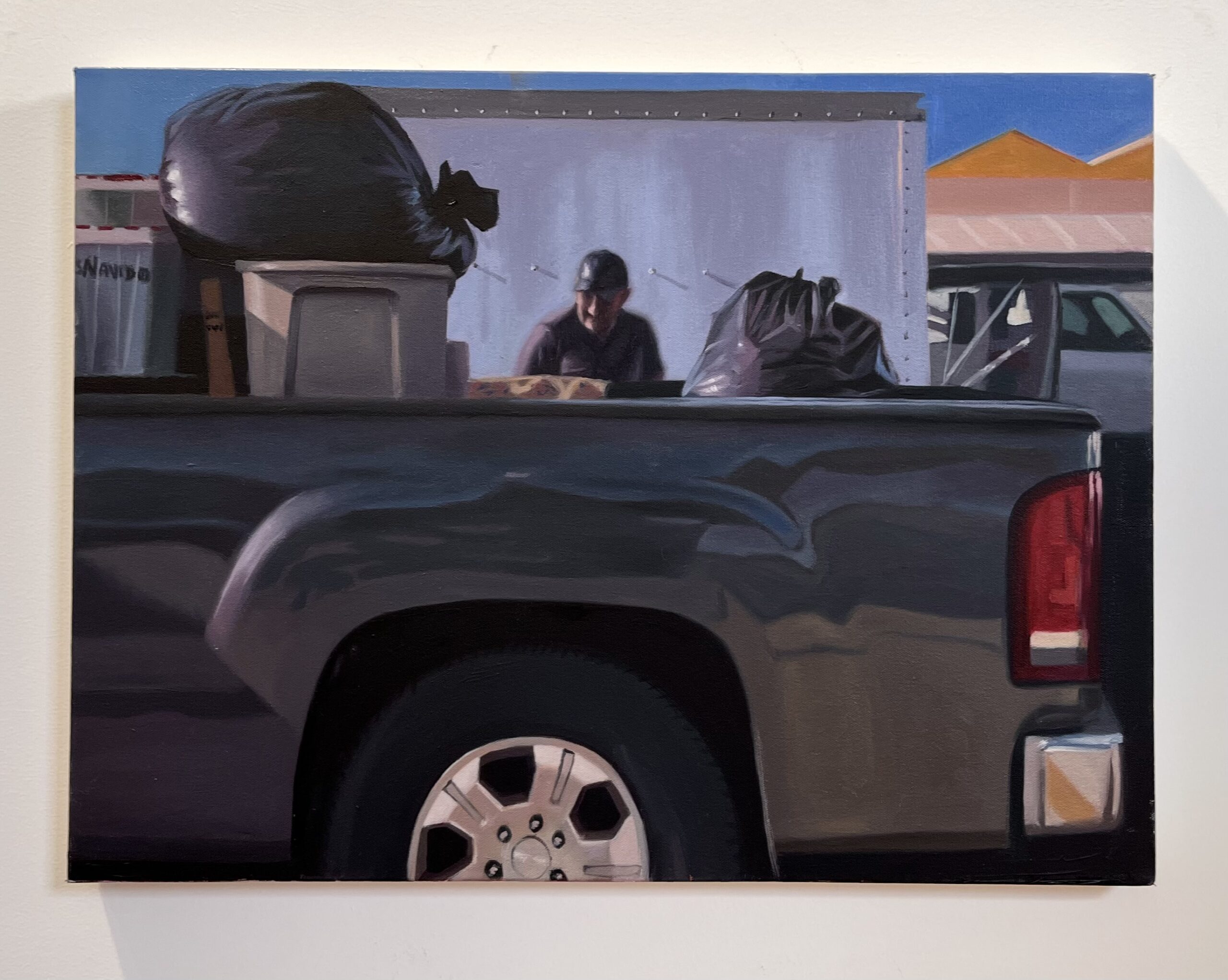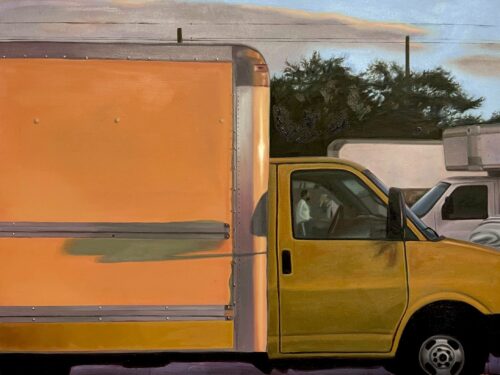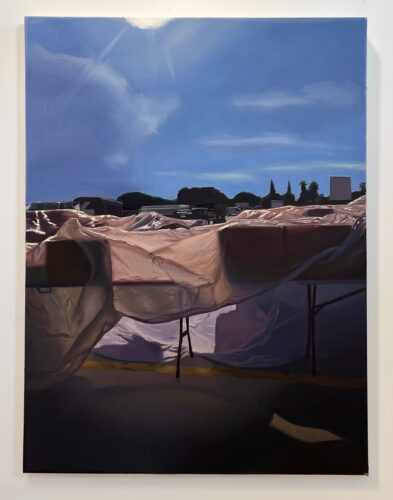Artburst Extras
Marie Franco Illuminates South Florida’s Immigrant Stories at Laundromat Art Space

“Rainy Day,” oil on Canvas, 2025, 42″ x 30″, is one of the works featured in “A primera luz,” the debut exhibition of works by Maria Franco at Laundromat Art Space. (Photo by Maria Franco)
Miami-based artist Marie Franco’s debut solo exhibit, “A primera luz” (“At first light”) at Laundromat Art Space, brings the world of South Florida’s flea markets – their vendors, colors, and quiet moments of survival–onto the white walls of the gallery. On view through Monday, Nov. 24, the show offers an intimate portrayal of Latino immigrant life, told through oil paintings that radiate both warmth and resilience.
The exhibition title, Franco explains, is a tribute to the hours before dawn, when vendors begin their day. “The most important moment I’m trying to capture is the sunrise,” she says. “That’s a reflection of the hustle–waking up before the sun is, setting up before light breaks. The flea market is a loud place, but in my paintings, I look for the moments of quietness within that chaos.”
Franco’s visual theme is rooted in personal experience. Born to Peruvian–Venezuelan parents, she grew up around the Fort Lauderdale Swap Shop, one of the region’s most iconic immigrant marketplaces. “When I moved here, my mom was a vendor at the Swap Shop,” she recalls. “Even back in Venezuela, my mom had been a vendor. It’s the culture we carried with us. The flea market tells the story of migration–not just here, but everywhere.”

“A Primera Luz”, oil on canvas, 2025, 30”x42” (Photo by Maria Franco)
Her paintings depict these markets as both workplace and gathering place–sites where Caribbean and Latin American immigrants trade, talk, and build community. Each composition balances the busy geometry of tables and tarps with soft, painterly realism: sunlight cutting through industrial greens; skies washed in tropical blue and the human figures who animate the scene.
“A lot of people tell me my paintings are realistic, but that’s never my goal,” Franco says. “I’m a storyteller before a painter. I paint how it feels–the warmth, the light, the memory.”
Her color choices are instinctive, she adds, grounded in her sensory memory of mornings at the market. “The green is very industrial–like labor of it all–the blues are all about the sun. The sun decides the palette. I paint what the sunshine feels like, not just what it looks like.”
The Material of Community
Franco’s practice blurs the boundaries between artist and subject, documentation and participation. “A lot of these canvases actually come from the flea market itself,” she says with a smile. “Many were gifts from the vendors–they’ll find brushes, canvases, materials, and offer them to me before selling them. So even the materials carry that sense of community and support.”
The result is a series of paintings that elevate everyday labor into poetic expressions. Large–scale portraits of vendors,rendered in warm hues and contemplative poses, demand visibility for those often overlooked. “With immigration, we talk about numbers and statistics,” explains Franco. “But when you’re standing in front of a large portrait of a person, you can’t ignore them anymore. You have to confront their presence.”
For curator Ronald Sánchez, co-founder of Laundromat Art Space and often works with emerging Latin American artist, “A primera luz” is as much a curatorial statement as an artistic one. “I work with a lot of young artists – from new graduates to MFA students –and I focus primarily on Latin American art and current events,” he says. “When I first saw Marie’s paintings, I recognized some of these scenes immediately. I used to go to the Fort Lauderdale Swap Shop as a kid. I saw these tables, the bags, the branding–it felt familiar.”

The opening of “A primera luz” on Sunday, Nov 2 at Laundromat Art Space (Photo by Ana Vergara, courtesy of Laundromat Art Space)
Sánchez says that shared cultural familiarity guided his decision to present Franco’s first solo exhibition. “My goal as a curator is to lay a platform to amplify vision and voice for young artists,” he explains. “This show highlights the hustle – the everyday labor of Latino and Caribbean immigrants working toward a better life. It’s about pride in culture, but also a reflection on what connects us across all of Latin America.”
That connection extends to the exhibition location in Little Haiti; a neighborhood whose layered immigrant identities mirror the diversity in Franco’s portraits. “There are people from Trinidad, Jamaica, Haiti, and across Latin America,” says Sánchez. “It’s a reminder that Latin America isn’t just the Spanish-speaking countries – it’s all of it. And here in Miami, that overlap is what makes the art scene so rich.”
Moments of Recognition
Seeing “A primera luz” feels both documentary and dreamlike – a kind of visual ethnography painted with affection. One canvas, Franco notes, depicts a mother and daughter at work in the market. “That painting feels like the anchor of the show,” she says. “It’s reflective of my own experience – me and my mom going to the market together to work. You see that dynamic everywhere in these spaces.”
The exhibition’s central paintings – two sunrise scenes paired side by side – glows with quiet reverence. “They represent that same moment, even though they were painted on different days,” explains Franco. “Together, they capture what the title means – that first light of day, the persistence that defines the immigrant story.

“Rainy Day”, oil on canvas, 2025, 42″x30″ (Photo by Maria Franco)
Both the artist and curator emphasize that “A primera luz” is ultimately about visibility–not just of people, but of the spaces that sustain them. “These places are vital,” says Franco. “The flea market is a workplace, but also a community hub. It’s part of the backbone of the economy, and it deserves preservation. Since COVID, the Swap Shop has declined, but it’s still a lifeline for many immigrant families. I want people to see that.”
Sánchez says the artist is bringing the stories into the gallery where they can be seen as and and as culture.
“That’s important. It enriches the conversation about who we are as Miamians.”
For viewers, “A primera luz” offers more than nostalgia. It’s a mirror of Miami itself – a mosaic of migrations, economies, and dreams made tangible in paint. Franco’s voice joins a growing generation of South Florida artists reclaiming the everyday as art, and the immigrant narrative as a cornerstone of the region’s identity.
As Franco reflects, “I feel very connected to both communities – the artists here in South Florida and the vendors at the flea market.” She mentions that some will come to view the show.
“They’ll see themselves in these portraits. That’s what this work is about –the community seeking itself in the light.”
WHAT: Marie Franco: “A Primera Luz”
WHERE: Laundromat Art Space, 5900 NE 2nd Ave., Miami
WHEN: Noon to 4 p.m., Wednesday through Saturday. Through Monday Nov. 24
COST: Free
INFORMATION: 303-960-7810 or laundromatartspace.com/contact
ArtburstMiami.com is a nonprofit media source for the arts featuring fresh and original stories by writers dedicated to theater, dance, visual arts, film, music and more. Don’t miss a story at www.artburstmiami.com.
